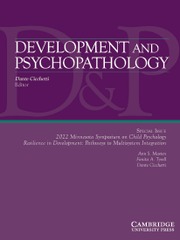Crossref Citations
This article has been cited by the following publications. This list is generated based on data provided by
Crossref.
Lewis, Dorothy Otnow
and
Yeager, Catherine A.
2000.
Preface.
Child and Adolescent Psychiatric Clinics of North America,
Vol. 9,
Issue. 4,
p.
xi.
Kaufman, Joan
Plotsky, Paul M
Nemeroff, Charles B
and
Charney, Dennis S
2000.
Effects of early adverse experiences on brain structure and function: clinical implications.
Biological Psychiatry,
Vol. 48,
Issue. 8,
p.
778.
Christensen, Bruce K
and
Bilder, Robert M
2000.
Dual Cytoarchitectonic Trends: An Evolutionary Model of Frontal Lobe Functioning and Its Application to Psychopathology.
The Canadian Journal of Psychiatry,
Vol. 45,
Issue. 3,
p.
247.
Takahashi, Lorey K
2001.
Role of CRF 1 and CRF 2 receptors in fear and anxiety.
Neuroscience & Biobehavioral Reviews,
Vol. 25,
Issue. 7-8,
p.
627.
ZELKOWITZ, PHYLLIS
PARIS, JOEL
GUZDER, JASWANT
and
FELDMAN, RONALD
2001.
Diatheses and Stressors in Borderline Pathology of Childhood: The Role of Neuropsychological Risk and Trauma.
Journal of the American Academy of Child & Adolescent Psychiatry,
Vol. 40,
Issue. 1,
p.
100.
Schore, Allan N.
2001.
The effects of early relational trauma on right brain development, affect regulation, and infant mental health.
Infant Mental Health Journal,
Vol. 22,
Issue. 1-2,
p.
201.
Marshall, Randall D.
Beebe, Katherine L.
Oldham, Mary
and
Zaninelli, Rocco
2001.
Efficacy and Safety of Paroxetine Treatment for Chronic PTSD: A Fixed-Dose, Placebo-Controlled Study.
American Journal of Psychiatry,
Vol. 158,
Issue. 12,
p.
1982.
Wang, Wei
Dow, Kimberly E.
and
Fraser, Douglas D.
2001.
Elevated corticotropin releasing hormone/corticotropin releasing hormone‐R1 expression in postmortem brain obtained from children with generalized epilepsy.
Annals of Neurology,
Vol. 50,
Issue. 3,
p.
404.
Strathearn, Lane
Gray, Peter H.
O'Callaghan, FRCPI‡; Michael J.
and
Wood, David O.
2001.
Childhood Neglect and Cognitive Development in Extremely Low Birth Weight Infants: A Prospective Study.
Pediatrics,
Vol. 108,
Issue. 1,
p.
142.
Manji, Husseini K.
Drevets, Wayne C.
and
Charney, Dennis S.
2001.
The cellular neurobiology of depression.
Nature Medicine,
Vol. 7,
Issue. 5,
p.
541.
Coplan, Jeremy D
Smith, E.L.P
Altemus, Margaret
Scharf, Bruce A
Owens, Michael J
Nemeroff, Charles B
Gorman, Jack M
and
Rosenblum, Leonard A
2001.
Variable foraging demand rearing: sustained elevations in cisternal cerebrospinal fluid corticotropin-releasing factor concentrations in adult primates.
Biological Psychiatry,
Vol. 50,
Issue. 3,
p.
200.
Ghika-Schmid, F
Ansermet, F
and
Magistretti, P
2001.
Stress et mémoire.
Annales Médico-psychologiques, revue psychiatrique,
Vol. 159,
Issue. 9,
p.
632.
Korf, J.
Klein, H. C.
Versijpt, J.
den Boer, J. A.
and
ter Horst, G. J.
2002.
Considering depression as a consequence of activation of the inflammatory response system.
Acta Neuropsychiatrica,
Vol. 14,
Issue. 1,
p.
1.
Gunnar, Megan R.
and
Donzella, Bonny
2002.
Social regulation of the cortisol levels in early human development.
Psychoneuroendocrinology,
Vol. 27,
Issue. 1-2,
p.
199.
Wakschlag, Lauren S.
Pickett, Kate E.
Cook, Edwin
Benowitz, Neal L.
and
Leventhal, Bennett L.
2002.
Maternal Smoking During Pregnancy and Severe Antisocial Behavior in Offspring: A Review.
American Journal of Public Health,
Vol. 92,
Issue. 6,
p.
966.
Ryzhavskii, B. Ya.
2002.
Effect of Injection of Testosterone Derivatives to Pregnant Rats on the Brain of Their One-Day Offspring.
Bulletin of Experimental Biology and Medicine,
Vol. 134,
Issue. 5,
p.
509.
Newport, D. Jeffrey
and
Nemeroff, Charles B.
2002.
Encyclopedia of the Human Brain.
p.
449.
Koehl, Muriel
Lemaire, Valérie
Mayo, Willy
Abrous, Djoher Nora
Maccari, Stefania
Piazza, Pier Vincenzo
Moal, Michel
and
Vallée, Monique
2002.
Individual vulnerability to substance abuse and affective disorders: Role of early environmental influences.
Neurotoxicity Research,
Vol. 4,
Issue. 4,
p.
281.
Ohashi, Yoko
Stowell, Janet M
Nelson, Laura E
Hashimoto, Toshikazu
Maze, Mervyn
and
Fujinaga, Masahiko
2002.
Nitrous oxide exerts age-dependent antinociceptive effects in Fischer rats.
Pain,
Vol. 100,
Issue. 1,
p.
7.
Thadani, Pushpa V
2002.
The intersection of stress, drug abuse and development.
Psychoneuroendocrinology,
Vol. 27,
Issue. 1-2,
p.
221.

